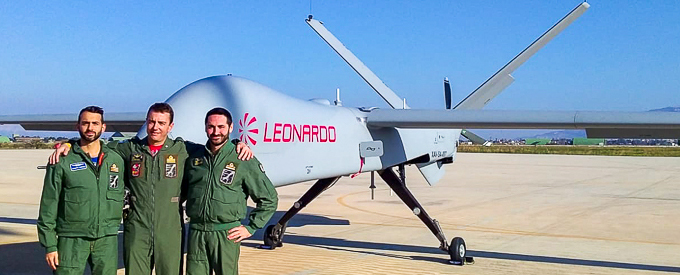2020-03-01
Italian Air Force: At the Forefront of Testing New Drones
Falco Xplorer is the state-of-the-art solution for surveillance for both military and civilian applications and is aimed at dual-use requirements, providing 24/7, all weather persistent regional surveillance, covering a wide range of missions and complementing typical military roles with governmental missions. In an exclusive interview with Nation Shield, Cap. Ettore P. of the Italian Air Force Flight Test Wing (Reparto Sperimentale di Volo), who managed the first flight of Falco Xplorer, explains the challenges involved and how it is best suited for surveillance in the Middle East.
By: Sakha Pramod
How is Falco Xplorer best suited for regional surveillance?
It has been designed to offer persistent, multi-sensor strategic surveillance to military and civilian customers and can be procured as either an integrated system or as a fully-managed information-superiority service, flown and operated by Leonardo. The native satellite link capability allows for beyond-line-of-sight operations and with a maximum take-off weight of 1.3 tonnes and an operating ceiling of 24,000ft, the aircraft is an affordable and potent option for Intelligence Surveillance and Reconnaissance (ISR).
Is Falco Xplorer RPAS ideal for multiple missions?
Falco Xplorer features a powerful sensor suite, which includes the Leonardo’s Gabbiano T-80 multi-mode surveillance radar, its SAGE electronic intelligence system, an automatic identification system for maritime missions and an Electro-Optical (EO) turret. An optional hyper spectral sensor will allow the Falco Xplorer to monitor pollution and agricultural development. The native satellite link capability allows for beyond-line-of-sight operations, while its open system architecture means that third-party sensors can be easily integrated. With such a sensor suite, the aircraft can easily adapt to various scenarios.
Why did the Italian Air Force manage the first flight of the Falco Xplorer?
An agreement of cooperation has been put in place by Italian Air Force and Leonardo to promote excellence on both sides: the industrial expertise on building remotely piloted air systems (RPAS) and the military test experience gathered by the Italian Ministry of Defence on RPAS over the last decade. Such synergistic cooperation allowed us to achieve the maximum performance in testing the Falco Xplorer, entrusting the Reparto Sperimentale di Volo (Flight Test Wing) with the primary duty of studying and conducting the flight test in support of operational squadrons, institutes of research, universities and industries. The combined team cooperated as a single entity, each providing their best capabilities to Italy.
How does it feel to be flying a brand-new RPAS for the first time?
It is extremely exciting and thrilling. The first flight is a key milestone of a flight test programme and we have been trained to achieve this objective. You are about to take airborne a system that nobody really knows how it will fly and behave, you have just a few moments to understand its behaviour and fly it at your best. I’m honoured to have had such an opportunity with Falco Xplorer. Dedication, attention to every single detail, study, intensive ground test and rehearsals that involved the entire team gave us the right attitude to approach the first flight with confidence.
How does it compare to other RPAS you have flown?
Every remotely piloted aircraft is different from all others: weight, dimension, propulsion system, data links are different. The Falco Xplorer is still a prototype undergoing multiple changes in configuration and adjustments throughout its campaign. However, the aircraft demonstrated a solid flight control system and it is intuitive to fly. We need to keep on flying in order to understand its strengths and weaknesses.
What is the most exciting part of a maiden flight?
The most exciting part was the take-off. We had the sun rising on the back of Falco Xplorer while it lined up on the runway at Trapani Air Base (southern Italy) and watching the aircraft’s shadow in front of us getting smaller and smaller while lifting off was thrilling. I have to admit though that the most emotional part was realising after touchdown, when the aircraft stopped for a second on the runway, that we made the first flight and we made it safely. It was the first time I realised the achievement and this completely paid off the effort of months of hard work.
What is the most difficult part of an RPAS mission, and how do you handle it?
I identify two difficult parts of an RPAS mission. The first one is the total absence of any physical feedback despite the visual cues, which are always present. The second one is the feeling of having a technologically advanced system very far away from where you are controlling it, with a limited amount of data to evaluate the situation and still being able to successfully perform the mission with other aircraft and personnel that rely greatly on your support.
What makes Falco Xplorer different from any other RPAS you have piloted?
First of all, it was the first time that I participated in a real “maiden flight”. Therefore, while with previous RPAs I flew I had a better idea of how the aircraft would perform in terms of performance, flying and handling qualities, with Falco Xplorer the thrilling part was to discover many of its characteristics.
How does its ground control communication system work?
As with every other component of the Falco Xplorer, the communication system is entirely developed by Leonardo. It has a triple-redundant line-of-sight link that allows the crew to operate the aircraft without a perceptible delay. Furthermore, it will have a satellite link installed, allowing it to operate beyond-line-of-sight multiplying its performance and operational distance.


No Comments